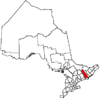Madoc, Ontario (township)
Madoc | |
|---|---|
| Township of Madoc | |
 Municipal office | |
| Coordinates: 44°35′N 77°31′W / 44.583°N 77.517°W | |
| Country | Canada |
| Province | Ontario |
| County | Hastings |
| Settled | Early 19th century |
| Incorporated | 1850 |
| Government | |
| • Type | Township |
| • Reeve | Loyde Blackburn |
| • Federal riding | Hastings-Lennox and Addington |
| • Prov. riding | Hastings-Lennox and Addington |
| Area | |
| • Land | 277.97 km2 (107.32 sq mi) |
| Population (2021)[2] | |
• Total | 2,233 |
| • Density | 8.3/km2 (21/sq mi) |
| Time zone | UTC-5 (EST) |
| • Summer (DST) | UTC-4 (EDT) |
| Postal Code | K0K 1Y0 |
| Area code(s) | 613 and 343 |
| Website | www |
Madoc is a township in Hastings County in Eastern Ontario, Canada.
The township was named after Welsh prince Madoc ap Owain Gwynedd, credited by some with discovering North America in 1170. There exists an alternative explanation, for which no evidence exists, that the name comes from a small Welsh village, Llanmadoc, on the Gower Peninsula of Wales, not far from the city of Swansea. Its post office dates from 1836.[3]
Communities
[edit]The township of Madoc comprises several villages and hamlets, including communities such as Allen, Bannockburn, Cooper, Eldorado, Fox Corners, Hazzards Corners, Keller Bridge, Rimington, and Empey.
-
Eldorado (2010)
-
Bannockburn
History
[edit]
Mills and ironworks gave initial stimulus to the community of Madoc. Following the discovery of gold-bearing quartz in 1866,[4] the community prospered as an industrial centre.[5] Eldorado, 6 miles north of Madoc, was the site of Ontario's first gold rush on 18 August 1866 by Marcus Powell and William Berryman (or Nicholas Snider). The opened up a limestone cave 12 feet long, 6 feet wide and 6 feet high. The resultant mine was named the Richardson Mine, after John Richardson, owner of the farm where it was located. People soon came from all over North America to this area.[6]
Demographics
[edit]In the 2021 Census of Population conducted by Statistics Canada, Madoc had a population of 2,233 living in 868 of its 934 total private dwellings, a change of 7.5% from its 2016 population of 2,078. With a land area of 274.58 km2 (106.02 sq mi), it had a population density of 8.1/km2 (21.1/sq mi) in 2021.[7]
| 2021 | 2016 | 2011 | |
|---|---|---|---|
| Population | 2,233 (+7.5% from 2016) | 2,078 (-5.4% from 2011) | 2,197 (6.2% from 2006) |
| Land area | 274.58 km2 (106.02 sq mi) | 277.97 km2 (107.32 sq mi) | 277.97 km2 (107.32 sq mi) |
| Population density | 8.1/km2 (21/sq mi) | 7.5/km2 (19/sq mi) | 7.9/km2 (20/sq mi) |
| Median age | 49.6 (M: 49.2, F: 50.0) | 49.4 (M: 49.9, F: 48.9) | 45.8 (M: 46.0, F: 45.7) |
| Private dwellings | 934 (total) 868 (occupied) | 889 (total) | 894 (total) |
| Median household income | $79,000 | $63,539 |
| Year | Pop. | ±% |
|---|---|---|
| 1986 | 1,645 | — |
| 1991 | 1,869 | +13.6% |
| 1996 | 2,031 | +8.7% |
| 2001 | 2,044 | +0.6% |
| 2006 | 2,069 | +1.2% |
| 2011 | 2,197 | +6.2% |
| 2016 | 2,078 | −5.4% |
| 2021 | 2,233 | +7.5% |
| Source: Statistics Canada[1][2][13] | ||
Notable people
[edit]- Charles Wilson Cross – Canadian politician. First Attorney-General of Alberta (1912–1918)
See also
[edit]References
[edit]- ^ a b "Madoc census profile". 2011 Census of Population. Statistics Canada. Retrieved 2012-03-02.
- ^ a b "Census Profile, 2016 Census: Madoc, Township". Statistics Canada. 8 February 2017. Retrieved June 15, 2019.
- ^ Hamilton, William (1978). The Macmillan Book of Canadian Place Names. Toronto: Macmillan. pp. 157. ISBN 0-7715-9754-1.
- ^ Pain, S.A. (1960). Three Miles of Gold. Toronto: The Ryerson Press. p. 7.
- ^ "Archived copy". Archived from the original on 2012-04-03. Retrieved 2011-03-11.
{{cite web}}: CS1 maint: archived copy as title (link) Ontario Heritage Trust Founding of Madoc - ^ Barnes, Michael (1995). Gold in Ontario. Erin: The Boston Mills Press. pp. 13–15. ISBN 155046146X.
- ^ "Population and dwelling counts: Canada, provinces and territories, census divisions and census subdivisions (municipalities), Ontario". Statistics Canada. February 9, 2022. Retrieved April 2, 2022.
- ^ "2021 Community Profiles". 2021 Canadian census. Statistics Canada. February 4, 2022. Retrieved 2023-10-19.
- ^ "2016 Community Profiles". 2016 Canadian census. Statistics Canada. August 12, 2021. Retrieved 2019-06-15.
- ^ "2011 Community Profiles". 2011 Canadian census. Statistics Canada. March 21, 2019. Retrieved 2012-03-02.
- ^ "2006 Community Profiles". 2006 Canadian census. Statistics Canada. August 20, 2019.
- ^ "2001 Community Profiles". 2001 Canadian census. Statistics Canada. July 18, 2021.
- ^ 1996, 2001, 2006 census




